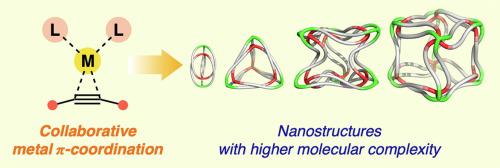Coordination Chemistry Reviews ( IF 20.6 ) Pub Date : 2022-05-16 , DOI: 10.1016/j.ccr.2022.214605 Yuya Domoto, Makoto Fujita

|
The coordinative self-assembly of relatively simple building blocks toward complex nanostructures is currently of high interest in the context of developing artificial nanomaterials that are comparable to biological systems. Even though a substantial body of research has already been assembled, only few classes of coordination donors, namely, nitrogen- or oxygen-containing donors, have historically been used, as research has focused predominantly on the robustness and designability of the coordinated structures. As an alternative approach, the use of the relatively weak but loosely directed π-coordination between metal ions and unsaturated carbon–carbon bonds has emerged; this strategy is expected to provide structurally flexible and highly tolerant bonding in complex nanoarchitectures. Most prominently, studies that combine metal–acetylene π-coordination with conventional coordination have recently realized the formation of very large discrete polyhedral complexes with unprecedented molecular entanglement based on trifurcate motifs, which represent the tip of the iceberg in terms of the potential advantages of this concept.
中文翻译:

基于金属⋯不饱和键配位的高复杂度纳米结构自组装
在开发可与生物系统相媲美的人造纳米材料的背景下,相对简单的构建块向复杂纳米结构的协调自组装目前引起了人们的高度关注。尽管已经进行了大量研究,但历史上只有少数几类配位供体,即含氮或含氧供体,因为研究主要集中在配位结构的稳健性和可设计性上。作为一种替代方法,使用金属离子和不饱和碳-碳键之间相对较弱但方向松散的 π-配位已经出现。该策略有望在复杂的纳米结构中提供结构灵活且高度耐受的键合。最突出的是,


























 京公网安备 11010802027423号
京公网安备 11010802027423号